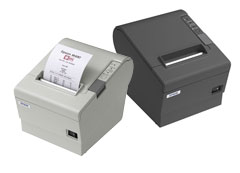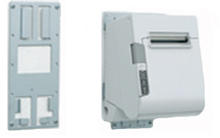Epson TM-T88IV

Thermal Receipt Printers
Latest generation of industry leading TM-T88 series
| Model Name | TM-T88IV | |
| Print Method | Thermal line printing | |
| Print Font | 9 x 17 / 12 x 24 | |
| Column Capacity (columns) | 56 / 42 | |
| Character Size (mm) | 0.99 (W) x 2.4 (H) / 1.41 (W) x 3.39 (H) | |
| Character Set | 95 Alphanumeric, 37 International, 128 × 11 Graphic Traditional / Simplified Chineese, Japanese, Korean |
|
| Bar Code | UPC-A, UPC-E, JAN8 (EAN), JAN13 (EAN), CODE39, CODE93, CODE128, ITF, CODABAR Two-dimensional code: PDF417, QRCode | |
| Character Per Inch | 20 CPI / 15 CPI | |
| Interfaces | RS-232, Bi-directional parallel, Dealer Option: RS-486, USB, 10 Base-T I/F |
|
| Data Buffer | 4K bytes / 45 bytes | |
| Print Speed | Max. 200mm/sec | |
| Paper Dimensions (mm) | Roll paper: 79.5 ± 0.5 (W) × dia. 83.0 | |
| Paper Thickness (mm) | 0.06 to 0.07 | |
| Power | 24 VDC ± 7% | |
| Power Consumption | Approx. 1.8 A (mean) | |
| D.K.D. Function | 2 drives | |
| Reliability | ||
| MTBF | 360,000 hours | |
| MCBF | 52,000,000 lines | |
| Overall Dimensions (mm) | 145 (W) x 195 (D) x 148 (H) | |
| Mass (Approx) | 1.8 kg | |
| EMC Standards | FCC, VCCI Class A, CE marking, AS / NZS CISPR22 class B |
|
| Power Supply (option) | PS-180 | |
| Option | Wall-hanging bracket WH-10 | |
| Safety Standards | UL / CSA / EN | |
 |
|
Optional mounting bracket available for hanging the printer on the wall |
Usage Conditions
Epson products are designed and made to give highly reliable use
and long life when used according to its specifications. With any system, product
or device used in situations where human life may be involved or at risk,
Epson advises that you should take all necessary steps to ensure the suitability
of your Epson product for inclusion in your system, and recommends that you
include fail-safe procedures and redundancy support or backup equipment in your system,
to maintain the maximum safety margin and optimum system reliability.

